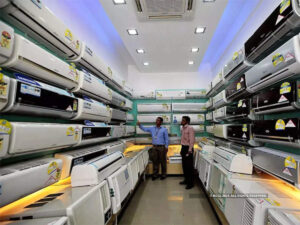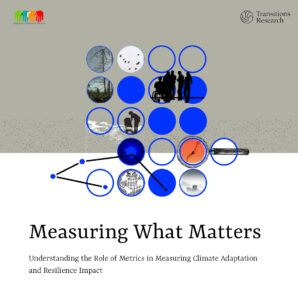
The power sector is the biggest source of greenhouse gas emissions in India, accounting for 32% of total emissions in 2022. Approximately 95% of electricity in India currently comes from coal. Large-scale wind, tidal, and solar projects, as well as subsidies for decentralised solar plants, are seeking to increase the proportion of renewable energy. This is a laudable drive. However, no form of power generation is resource-free; every form of power has environmental costs. Energy efficiency must therefore be prioritised in parallel with investments in renewable energy. Given rapid urbanisation, given that households account for 24% of total power consumption, given that across socioeconomic strata power consumption contributes the largest share of household-level emissions, given that per-capita power consumption is substantially higher in urban than in rural households, and given that this trend is projected to continue – encouraging energy-efficient practices in urban Indian households will be crucial for India to achieve net zero.
It’s estimated that adopting energy-efficient practices can lead to massive savings in India; but most of this savings potential, as of 2019, remained untapped. How do we explain this? One relevant factor is that, across sectors, electricity tariffs in India are among the lowest in the world. While this may have helped India catch up economically, it also means that high-emitting households lack the incentive to become energy-efficient.
Established policies: Bureau of Energy Efficiency’s energy audits and star labelling system
India’s Bureau of Energy Efficiency (BEE) requires industries to conduct annual internal energy audits, a move BEE claims has achieved an emissions reduction of 31 million tonnes of carbon dioxide equivalent (CO2e) per year. BEE does not currently require audits from the residential sector.
The BEE policy most relevant to households is the star labelling policy, which rates appliances based on energy efficiency. Independent research finds that BEE’s star labelling guidelines resulted in a cumulative reduction in household electricity bills of Rs.94,000 crore in 2021-22 alone. This corresponds to an impressive quantum of avoided emissions.
Another independent assessment suggests that, from 2006-2020, consumer behaviour shifts linked to the star labelling system resulted in 397 million tons of avoided emissions from refrigerators and air-conditioners alone.
Manufacturers are increasingly using the star rating system to advertise the environmental benefits as well as the long-term cost savings of higher-star appliances. BEE plans to make this currently voluntary programme mandatory for many household appliances by 2027. The star labelling system will thus likely remain an effective and evolving policy tool in India’s energy efficiency trajectory.
Newly launched policies: Dynamic tariffs
The Indian government has long toyed with the idea of dynamic tariffs. Dynamic tariffs operate on the same principle as surge pricing: when demand rises, so does cost. Dynamic pricing offers a potential solution to a long-running problem: balancing the power grid.
Typically, overall power consumption is lower during the day, when employees and students share indoor spaces, and higher in the evenings and nights, when domestic air-conditioners get more use. Currently, however, consumers across sectors pay the same flat tariff per unit consumed within their total consumption slab. This hour-to-hour imbalance between power generated and power demanded leads to loadsheddings, and also necessitates investments in resource-intensive excess power-generation plants and infrastructure upgrades. All this increases total emissions.
Dynamic tariffs might help shift the use of some high-consuming domestic appliances, such as washing machines, to lower-demand times of the day, as well as help raise awareness about energy-efficient use of air-conditioners at night.
Beginning this April, commercial and industrial consumers in some Indian states began to be subject to dynamic power pricing. Similar tariff reforms are expected for residential consumers soon. State-wise tariffs may be set up to 20% lower during the day and 20% higher at night. While total energy consumed might still remain the same, dynamic pricing may potentially help balance the grid, reduce the need for excess power-generation capacity, and thus facilitate energy efficiency and effectively cut total emissions. But we must wait to observe the actual effects of this policy across urban Indian households.
Newly launched policies: Smart metering
One key barrier to household energy efficiency is lack of information about which appliances consume how much electricity. The typical household consumer’s knowledge on this issue probably ends with knowing that air-conditioners are power-guzzlers, and that LED lights are more efficient than fluorescents. Residents receive a bill once a month, showing total units consumed and the bill amount. This kind of billing format lacks the granular data household consumers need to practise energy efficiency.
Smart meters, which display real-time energy consumption, might help bridge this information gap. India has so far installed 8 million smart meters, out of a total of 250 million sanctioned for installation by 2025-26. These smart meters, with their in-home displays which make available real-time data on electricity consumption, may prove a key tool in equipping urban households with one of the data streams they need to become more energy-efficient. Studies in the United Kingdom and China suggest that smart meters do lead to real if modest gains in household energy efficiency.
Policies needed: BEE, tariffs, and normative shifts
Given that BEE’s mandatory energy audits have substantially reduced industrial-sector emissions, mandating homeowners to conform to energy efficiency standards might offer similar benefits. From the impact and equity standpoints, such a programme should focus on larger, wealthier group housing societies, flat complexes, and gated communities, where per-capita emissions are seven times higher than in poorer neighbourhoods. In parallel, government-subsidised buyback or exchange programmes of energy-inefficient appliances might incentivise residential consumers to make the switch. Some rebates and other incentives are already available in this regard.
Awareness of BEE’s star-labelling system and its implications remains low. As of 2020, only 25% of residential consumers reported awareness of energy-efficient alternatives for household appliances; awareness was higher in urban households than rural. Clearly, concerted information campaigns are needed to raise awareness and adoption of energy-efficient appliances in urban Indian households. Encouragingly, the market for energy-efficient appliances is growing.
Raising power tariffs across the board, in a progressive and equitable fashion, would be the simplest way to incentivise energy efficiency. However, such a move would be politically very unpopular and is thus unlikely. Green tariffs – where consumers commission certified-green energy from DISCOMs at special rates – will realistically play a much more crucial role in reducing emissions from coal-based energy.
With conspicuous consumption on the rise, a key piece of the energy efficiency puzzle will be a shift in social norms such that lower electricity consumption, rather than higher, is socially valourised. Worldwide trends suggest that, as a nation’s median income rises, short-term and self-centred survival and prestige concerns wane, while altruistic concerns rise. (This concern does not always translate to action. Per-capita emissions remain much higher in wealthier nations.) India may already be experiencing a similar normative shift, with younger generations, in particular, expressing increasing concerns around climate and environment. The time may be ripe for a social-marketing approach to climate action in India. Given that electricity consumption in urban households contributes a substantial chunk of India’s emissions, such an approach would prominently incentivise increased energy efficiency and decreased overall energy consumption in urban Indian households.




